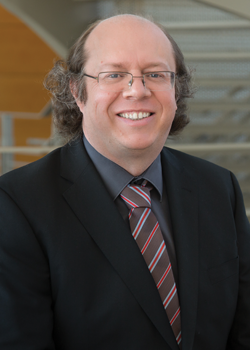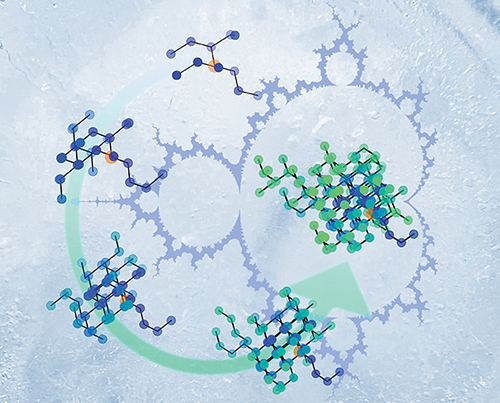The Right Place at the Right Time

Alan Tennant
(Photo Credit: Genevieve Martin,
Oak Ridge National Laboratory)
Alan Tennant, in his telling, "kind of fell into neutrons." Even so, it takes more than serendipity to see your name consistently pop up in breakthroughs related to these seemingly mild-mannered but powerful particles.
Neutrons are the centerpiece of Tennant's work to find out what's going on in materials that drive technological progress but keep a lot of secrets. He brought this expertise to UT when he joined the Quantum Materials for Future Technologies research cluster in early 2022. With a faculty position split 50-50 between the Department of Physics and Astronomy and the Department of Materials Science and Engineering, his appointment capitalizes on his deep experience in leading through innovation.
Tennant grew up in Galashiels, an industrial town of roughly 12,000 near Edinburgh, Scotland. Weekly trips to the library fed an insatiable curiosity that began early. As a kid he liked to build things all the time (a trait his two kids have inherited).
"I was interested in science and physics early on," he said. "I started getting interested in lasers and things like that when I was about five years old."
After earning a bachelor's degree in physics at Edinburgh University, Tennant headed to Oxford University. He planned to go into semiconductor research and technology until Professor Roger Cowley offered him a spot in his lab. Cowley had an illustrious reputation as a solid-state physicist and neutrons played a key role in his work. And so, Tennant said, "I kind of fell into neutrons."
That move sparked his interest in combining computational physics with neutron technologies, especially spallation sources. Tennant saw the potential for uncovering mysteries in quantum science—systems so small that classical physics can't describe them.
"From day one I've worked in quantum," he said. "I did some calculations on what would be feasible with neutrons and quantum systems. They convinced me there was a possibility for a revolution in that experimental field, which has been happening over the past three decades. I realized neutrons were able to do something potentially significant."
The revolution Tennant joined is big but its components are small. Much of modern life relies on knowing what electrons do; which materials conduct electronic current and which ones keep it from moving. Semiconductors like silicon claim the middle ground and made smartphones, LED lights, and laptops part of our everyday environment. This is well-understood territory for physicists and engineers. It's also the basis of a billion-dollar industry. As devices get smaller, however, materials like silicon reach their limits. To make ever-shrinking dimensions workable, scientists need to find, or design, new materials.
At scales this small quantum mechanics runs the show. Atoms and their constituents follow different rules. You may know how electrons interact in larger systems, but here all bets are off. If researchers can define subatomic behavior in quantum materials, they can impose some sense of control over their properties and build the foundation for stronger, lighter, faster systems in fields like energy, data science, and computing. In this quest scientists like Tennant have an unassuming but mighty tool: neutrons.
These neutral particles have a lot to offer. A beam of neutrons aimed at a sample becomes a non-destructive probe. Some pass right through, but others bounce off the material's nucleus. By mapping where they scatter, scientists learn about the atoms in a sample: where they are and how they move. Neutrons can also "see" atomic spins: a hint to the magnetism they foster. A bonus is that they cause no harm, making them an ideal package for quantum science.
"Neutrons are a big part of quantum," Tennant explained. "(They're) very kind, and come in as a quantum particle. It's like a quantum probe of a quantum system."
Neutrons are especially helpful when you're looking at complex quantum materials with lots of interacting particles. Calculating their dynamics can seem overwhelming, so any help in finding patterns and clues is welcome.
"Neutrons are a killer technique for that," Tennant said.
Tennant has a history of putting the neutron's killer technique to work in groundbreaking research. While ice and fractals make for catchy lyrics in Disney's Frozen, he has a more scientific take. A decade ago he was part of a team that used neutron scattering to find magnetic monopoles. Magnets have a north and a south pole, but magnetic monopoles have only one. They'd been predicted by theory but never seen until Tennant and his colleagues found them in spin ices, so named because their spin interactions mimic those of hydrogen bonds in ice. The work made Science magazine's list of 2009 breakthroughs.

Example of the fractal structures in spin ice together with a famous example of a fractal (the Mandelbrot set), on top of a photograph of water ice.
In work published in Science, Tennant and colleagues found a fractal introduced by the interplay of magnetic monopoles and spin ice's crystal structure. Using neutrons to reveal patterns and magnetic properties in these materials could be as important to quantum science as the understanding of electrons has been to modern electronics.
Image Credit: Jonathan Nilsson Hallén, Cavendish Laboratory, University of Cambridge
Last December Tennant and collaborators found more surprises in spin ice when they uncovered a new type of fractal (also published in Science). In simple terms, fractals are patterns that repeat at ever smaller sizes. They appear in nature in phenomena as varied as snowflakes and the tributaries of rivers. In this work, researchers found a fractal introduced by the interplay of magnetic monopoles and the spin ice's crystal structure. Using neutrons to reveal patterns and magnetic properties in these materials could be as important to quantum science as the understanding of electrons has been to modern electronics.
Such accomplishments have brought Tennant a raft of honors, including the EPS Europhysics Prize in condensed matter and election as a Fellow of the Neutron Scattering Society of America. While he appreciates the accolades, he doesn't see them as the ultimate mark of a successful scientist.
"Real leadership is innovating," he said. "And innovation is ultimately an intellectual and creative pursuit."
Tennant has a long list of such pursuits, including teaching, research, and leadership positions in the U.S., the United Kingdom, Germany, and Denmark. He has led the Oak Ridge National Laboratory Labwide Quantum Materials Initiative, served as chief scientist of the ORNL Neutron Sciences Directorate, and been head of the Institute of Complex Magnetic Materials at the Helmholtz Center Berlin, Germany. He is currently director of the Shull Wollan Center, the successor to the UT-ORNL Joint Institute of Neutron Sciences. He's also part of the Quantum Science Center at ORNL.
Tennant said he's glad now to be firmly planted in East Tennessee with his roles at UT and the national lab. His two sons and his wife ("she's the social one, but I tag along," he joked) like living here, and they have plenty of opportunities for tennis, gardening, and other family activities. That is, when he's not doing science.
His broad experience bodes well for UT's quantum cluster, which pools faculty talent across materials science, electrical engineering, computer science, and physics to position the university as a leader in quantum science.
UT's becoming head of the pack in all of this. We've become nationally significant. It's the right place at the right time.
"It's completely a team effort," Tennant said. "I think this really works, bringing people together to work on challenging problems. You want to have strength and depth where different people can take over roles."
With solid leadership in theory, experiment, and computation, he sees the university as a research powerhouse.
"That's positioning us in a very interesting realm in contemporary science," he said. "UT's becoming head of the pack in all of this. We've become nationally significant. It's the right place at the right time."
For Tennant, the cluster opportunity was a welcome return to university life after years of leading large-scale research facilities. He said teaching requires faculty to continually refresh their understanding of the basics while helping guide the field's future. Professors train students, who then train students of their own.
"In a way that's more impactful than management," he said. "You can see that reflected in why so many innovations and great ideas come from universities; because you're continuously recreating your subject."
In 2023 he's teaching courses on neutron science and quantum materials open to students across departments.
"That's also part of the cluster vision," he said, "to deliver courses that can be accessed across the university and start forming a curriculum so that UT students are offered something which isn't available everywhere."
That, he said, is a unique benefit for graduate students interested in quantum science. By choosing UT, he would tell them, you'll have access to "the right people; the right research; the right courses. You're going to be prepared for the future.""
Back to Cross Sections, Spring 2023